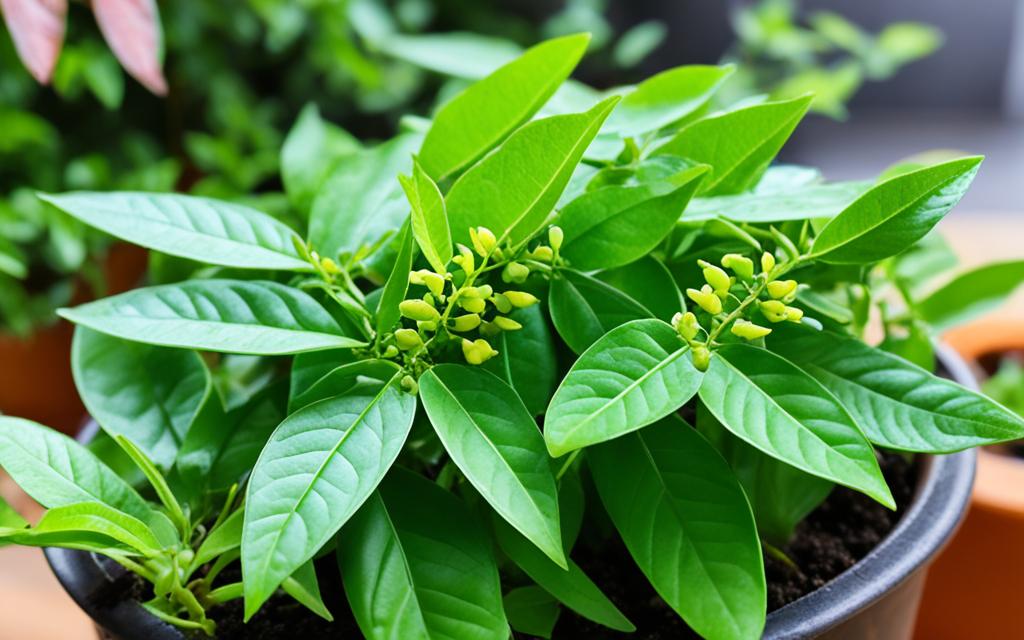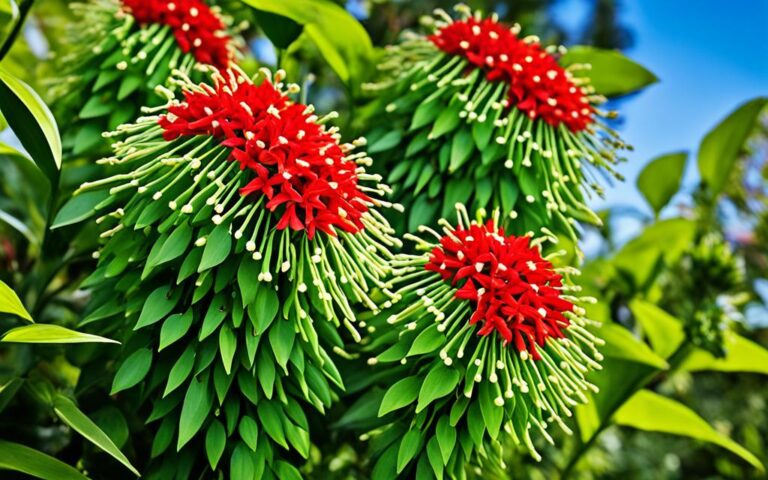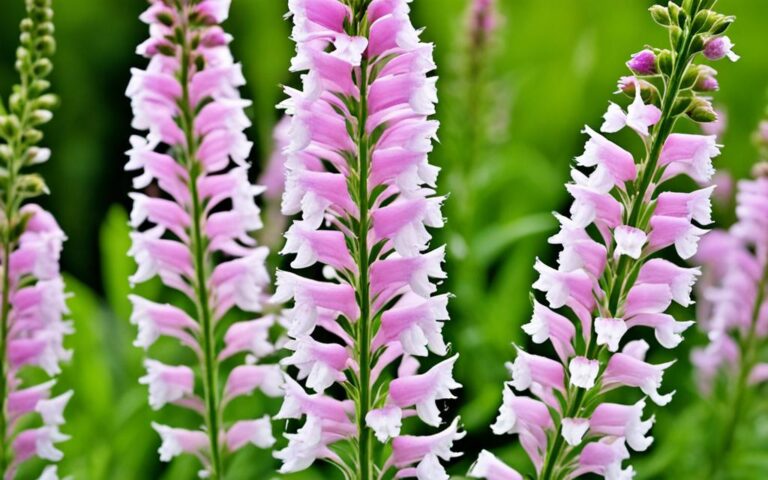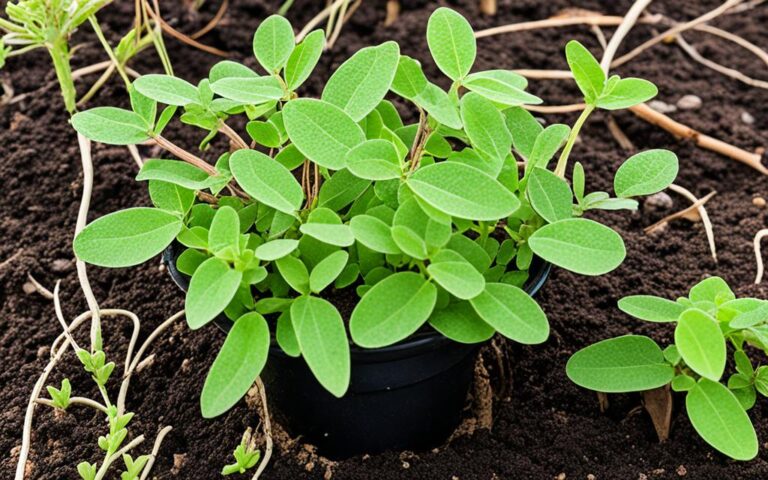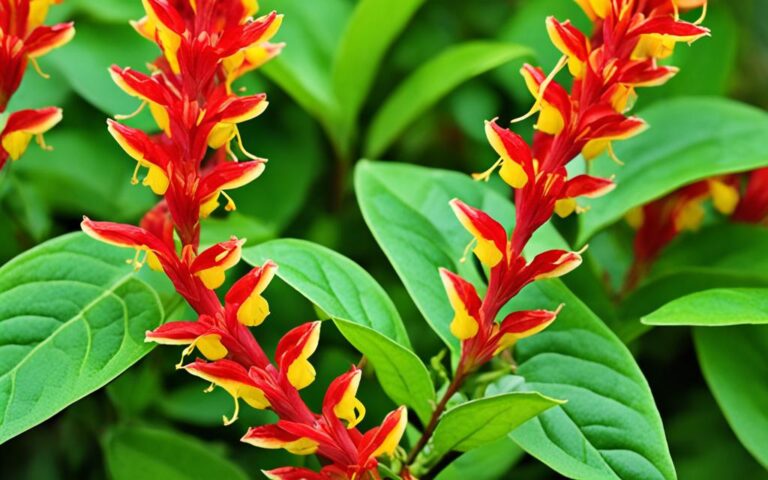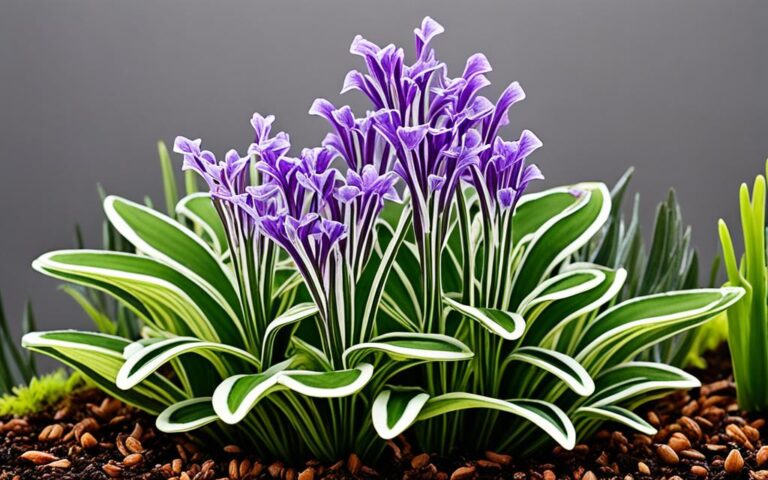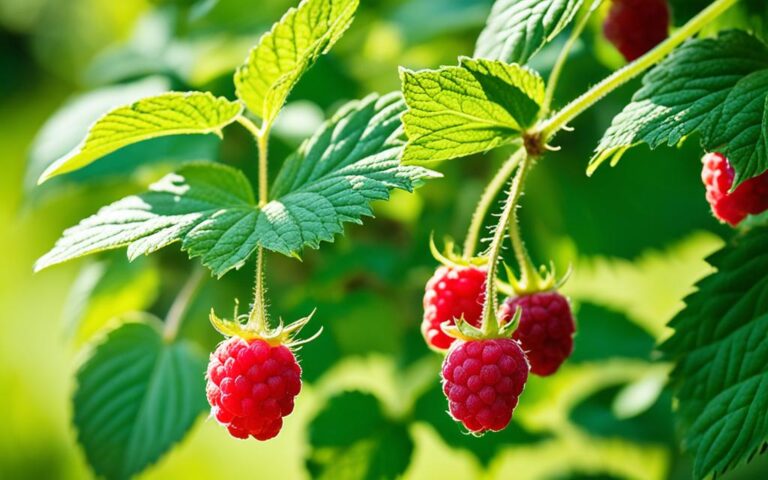Growing Curry Leaf Plants: Tips for Success
Did you know the curry leaf plant can grow up to 20 feet tall in the wild? Yet, it can thrive in small spaces, like home gardens or containers. This makes it perfect for those who love cooking and want to grow their own herbs.
This plant, also known as the curry tree or sweet neem, belongs to the citrus family. It’s a favorite in Indian, Filipino, and South Asian cooking for its unique flavor. Plus, it’s used in traditional medicine for its health benefits.
If you’re new or experienced in gardening, this guide is for you. It offers tips and techniques to grow a healthy curry leaf plant. With these steps, you’ll soon enjoy the plant’s aromatic and versatile leaves.
Key Takeaways
- The curry leaf plant is a versatile herb with both culinary and medicinal uses.
- Curry leaf plants can grow up to 20 feet tall in their native tropical regions, but can also be successfully grown in containers.
- Providing the plant with at least 6 hours of sunlight per day and well-draining, nutrient-rich soil is essential for healthy growth.
- Propagation can be done through seeds or cuttings, though germination from seeds can be challenging.
- Regular pruning and repotting can help maintain the plant’s vigor and productivity.
What Is a Curry Leaf Plant?
The curry leaf plant, known as Murraya koenigii, is a tropical evergreen shrub from the Indian subcontinent. It belongs to the citrus family. Its leaves are fragrant and aromatic, making them a key ingredient in Indian cuisine. The plant grows into a bush with showy flowers, making it great for tropical gardens and landscaping.
Origin and Description
This plant is native to India and Sri Lanka, where it loves the warm, humid weather. It can reach up to 20 feet tall in the wild, but garden plants are usually 4-6 meters (13-20 feet) tall. The plant’s trunk can be as wide as 40 centimeters (16 inches) and has pointed, oblong leaves that grow in pairs, with 11-21 aromatic leaflets.
In summer, the plant blooms with tubular white flowers that smell sweet and citrus-like. It’s an evergreen, keeping its leaves all year in its tropical home.
“The curry leaf plant is a versatile and valuable addition to any garden, offering both culinary and ornamental benefits.”
Importance and Uses of Curry Leaves
The leaves of the curry leaf plant, Murraya koenigii, are key in many cuisines. Countries like India, Philippines, Pakistan, Mexico, Sri Lanka, Cambodia, Malaysia, and Thailand use them. They’re known for their citrus flavor and health benefits.
In South Indian cooking, curry leaves start or end dishes, adding depth. They’re also big in Sri Lankan and Malaysian food. Their use is growing worldwide, even in North Indian cuisine.
Curry leaves are packed with protective compounds like alkaloids and phenolic compounds. These include linalool and alpha-terpinene, among others. Research shows they have many health benefits.
Studies highlight curry leaf extract’s medicinal uses, such as:
- Protecting against stomach damage and reducing oxidative stress
- Lowering cholesterol and triglyceride levels
- Potentially protecting against neurodegenerative diseases like Alzheimer’s
- Exhibiting anticancer properties and inhibiting the growth of breast cancer cells
- Helping in blood sugar control, reducing pain, and exhibiting anti-inflammatory effects
Traditionally, curry leaves aid digestion and protect the liver. They also help with hair care and eye health. They can fight bacteria and free radicals, and aid in weight loss by lowering triglycerides and cholesterol.
Curry leaves are gaining fans worldwide for their unique taste and health perks. They’re expected to become more popular in American cuisine, thanks to experts like Madhur Jaffrey.
Varieties and Cultivars
The curry leaf plant, Murraya koenigii, comes in various sizes for different needs and tastes. Gardeners can pick from standard, dwarf, and miniature varieties. These options make it easy to add this fragrant and tasty herb to your garden.
Standard, Dwarf, and Miniature Varieties
The standard curry leaf plant can grow up to 15 feet tall and spread 4 to 8 feet wide. These plants are perfect for outdoor gardens. On the other hand, the dwarf and miniature varieties are compact. They are great for container gardens and indoor spaces.
All curry leaf plants stay green all year and have a beautiful growth habit. This makes them great for decorative gardens. You can choose a size that fits your space and growing conditions.
| Variety | Height | Spread | Suitability |
|---|---|---|---|
| Standard | 6-15 feet | 4-8 feet | Outdoor gardens |
| Dwarf | 3-6 feet | 2-4 feet | Containers, indoor growing |
| Miniature | 1-3 feet | 1-2 feet | Containers, indoor growing |
No matter the size of your garden or indoor space, there’s a curry leaf plant for you. These varieties let you bring this versatile and flavorful herb into your garden or kitchen.
Growing Conditions
In the United States, the curry leaf plant (Murraya koenigii) does well in USDA Hardiness Zones 8-12. It loves a warm, tropical climate. It can grow in full sun to part shade. But, it does best with at least 6 hours of direct sunlight daily.
Soil and Water Needs
The curry leaf plant needs loose, rich, well-draining soil that’s a bit acidic. The ideal pH is 5.6-6.0. Make sure the soil isn’t too wet, as the plant doesn’t like wet feet.
Once it’s established, the curry leaf can handle semi-drought conditions. But, it needs regular watering, especially when it’s young.
“Even in dire situations, curry leaf plants can show signs of resiliency and potential new growth, as observed by Jes Thomas during plant care experiences.”
Zainab “Zee” Husain, co-founder of Sacramento-based heritage plant nursery Kula Nursery, says regular watering is key for the first two months after planting a curry tree. After that, moderate watering is enough. For potted curry plants, Husain suggests watering every 2 to 4 days, depending on the climate and pot size.
In tropical areas, curry leaf plants can grow outside all year. But in colder places, they should be in pots and moved indoors during winter to avoid frost and cold.
Propagation Methods
The curry leaf plant can be grown from seed or cuttings. Each method has its own benefits and things to consider for success.
Growing from Seed
For growing curry leaf plants from seed, use fresh, dried seeds. Plant them indoors or directly in the ground when it’s warm enough, above 65°F (18°C). Soaking the seeds in water for a day helps them sprout better.
But, keep them out of direct sunlight during germination. It’s too harsh for the young plants.
Growing curry leaf plants from seed is possible but tough. It takes longer and not all seeds germinate. It may take years for the plants to be big enough to use.
Propagation by Cuttings
Taking cuttings is easier and faster for growing curry leaf plants. Cut a 3 to 6-inch (7.6 to 15.2 cm) stem, remove lower leaves, and dip it in rooting hormone. Then, plant it in a good potting mix. You can move rooted cuttings outside after 3 weeks, when the roots are strong.
Keeping the area warm and humid helps curry leaf cuttings grow. Avoid direct sunlight at first to help roots form.
| Propagation Method | Success Rate | Time to Maturity |
|---|---|---|
| Grow from Seed | Historically Low | Several Years |
| Grow from Cuttings | Relatively High | 3-6 Months |
Choosing the right care, like pruning, watering, and feeding, is key. It keeps the curry leaf plant healthy and growing well.
curry leaf plant
If you want to grow your own curry leaf plant, starting from seed is a great choice. It takes time, about two years, before you can pick leaves regularly. Make sure to use fresh, dried seeds for the best chance of success.
Germination and Seedling Care
First, remove the seeds from the berry’s flesh and pulp. Plant them 1/3 inch deep in good soil that drains well. Keep the soil moist until they sprout, which should happen in 2-3 weeks at 68°F soil temperature.
Outdoor Planting
When the seedlings are strong and it’s over 65°F outside, move them outside. Pick a spot that gets a lot of sun and has soil that drains well and is a bit acidic. With the right care, your curry leaf plant will do great and give you lots of tasty leaves.
“Growing curry leaf plants from seed is a slower process, but the satisfaction of watching your plant mature and produce those distinctive leaves is unmatched.”
Remember, growing curry leaf plants takes time. By following these steps, you can enjoy your own curry leaf harvest right in your garden.
Care and Maintenance
Proper care and maintenance are key for your curry leaf plants to flourish. Regular pruning and fertilizing help with healthy growth and lots of leaves.
Pruning and Training
Curry leaf plants do well with regular pruning. This makes them bushier and more compact. When they are about 6 months old, cut back 2 branches to help them branch out more.
As they grow, prune the top 3-4 inches of growth every spring. This keeps them bushy and healthy.
For taller plants, staking is a good idea to prevent them from bending or breaking in the wind. Use soft ties to attach the plant to a stake or trellis. This gives them support but lets them move a bit.
Fertilization
Curry leaf plants need a lot of nutrients to grow well. They love nitrogen-rich foods to keep their leaves green and healthy. Use a balanced 20-20-20 fertilizer or organic fish emulsion every 4-6 weeks when they’re growing.
Also, give them iron sulfate (20%) twice a year. This makes sure they get all the micronutrients they need. It keeps their leaves green and the plant healthy.
- Water the curry leaf plant every 2-3 days in the summer.
- Water the plant weekly during the fall season.
- Change the pot of the plant every year in the first 4 years.
- Replace the top 40-50 percent of the soil when changing the pot.
By following these tips on pruning and fertilizing, your curry leaf plant will thrive. You’ll get a great harvest every year.
Pests and Diseases
Curry leaf plants are usually tough but can face pests and diseases if their environment isn’t right. They might get attacked by aphids, mealybugs, scale insects, or get fungal diseases like powdery mildew.
Powdery mildew is a fungal disease that turns the leaves and stems of curry leaf plants white and powdery. Spotting it early and treating it with things like baking soda or milk spray is key to stopping it.
Spider mites can also bother curry leaf plants, making the leaves look bad and wilt. Using neem oil, a natural bug killer, can keep these pests away and keep the plant healthy.
- Curry leaf plants need at least 6 hours of direct sunlight every day to stay healthy and fight off pests and diseases.
- Too much water can cause root rot and turn the leaves yellow, making the plant more likely to get pests and diseases.
- Keeping the plants clean by removing bad leaves helps stop pests and diseases from spreading.
| Pest or Disease | Symptoms | Recommended Treatment |
|---|---|---|
| Powdery Mildew | White, powdery growth on leaves and stems | Organic fungicides, such as baking soda or milk spray |
| Spider Mites | Discoloration and wilting of leaves | Neem oil, a natural pesticide |
| Aphids | Leaves mottle and curl, introduction of mold fungus | Insecticidal soap, neem oil |
| Mealybugs | Leaves shrivel, premature fruit drop, leaf drop, twig dieback | Neem oil, insecticidal soap |
By keeping the right growing conditions, checking on the plants often, and using organic ways to prevent problems, gardeners can keep pests and diseases away from their curry leaf plants. This helps keep the plants healthy and full of life.
Harvesting Curry Leaves
Harvesting curry leaves is key to their care. Wait until the plants are at least 1 year old before taking leaves. This lets the plant grow strong and healthy. Then, you can take leaves by gently pulling the stem from the plant, taking a few at a time.
When to Harvest
You can take leaves all year, but the plant might give less during winter. To keep it healthy, only take 30% of the leaves at once. This way, the plant stays strong and keeps giving you fresh curry leaves for cooking and medicine.
The best time to harvest curry leaves is when they’re big and look great. Choose leaves that are green, firm, and without any damage. Don’t take too many leaves at once, as it can harm the plant and reduce future growth.
“Harvesting curry leaves is an art, requiring a delicate balance between meeting your culinary needs and ensuring the long-term health of your curry leaf plant.”
By following these tips, you’ll get a lot of curry leaves from your plant maturity. This way, you can enjoy them for a long time.
Preserving Curry Leaves
Keeping the flavor and smell of fresh curry leaves is key for enjoying them all year. With simple steps, you can keep these leaves fresh and use their unique taste in your dishes.
Freezing Curry Leaves
Freezing is a great way to keep curry leaves. Just wash and dry the leaves well, then put them in a sealed bag or container. Make sure to squeeze out the air before sealing. Frozen curry leaves stay good for up to a month, keeping their flavor and smell.
Drying Curry Leaves
Drying is another good way to keep curry leaves. Lay the leaves out on a baking sheet and dry them in a low oven (about 100°F) for 1-2 hours. They should be dry and crumbly. Dry them in the shade to keep their flavor. Once dry, store them in a sealed container for up to 6 months.
| Preservation Method | Shelf Life | Flavor Retention |
|---|---|---|
| Freezing | Up to 1 month | High |
| Drying | Up to 6 months | Moderate |
Choosing the freshest curry leaves is crucial for the best flavor and quality. With a bit of effort, you can enjoy the bright taste of curry leaves all year.
“Preserving curry leaves is a game-changer in the kitchen. The flavor they add to dishes is unmatched, and these simple preservation techniques make it easy to have them on hand whenever you need them.”
Culinary and Medicinal Uses
Curry leaves are a versatile ingredient with many uses in cooking and medicine. In India, the Philippines, Sri Lanka, and Southeast Asia, they are loved for their unique, citrusy flavor. They add a special taste to curries, rice dishes, lentils, and chutneys.
They are not just for cooking. Curry leaves are also used in traditional medicine for their health benefits. They are thought to help with inflammation, antioxidants, and digestion. This makes them a great addition to a healthy diet.
Cooking with Curry Leaves
Curry leaves are a must-have in many Indian and Southeast Asian dishes. They bring a unique flavor and aroma that’s hard to find elsewhere. Here are some ways to use them:
- Curries: Curry leaves are a key part of many curries, adding a special flavor and smell.
- Rice dishes: They’re often added to rice dishes like biryani and pulao to enhance the taste and aroma.
- Lentils and dals: The earthy, citrusy taste of curry leaves goes well with lentils and dals.
- Chutneys and pickles: Curry leaves are used in chutneys and pickles, adding depth and richness.
Medicinal Properties
Curry leaves are packed with health benefits, making them a great addition to your diet. Studies show they have many medicinal properties, including:
- Antioxidant and anti-inflammatory properties that may help with diabetes, arthritis, and some cancers.
- They could lower blood sugar levels, which is good for people with diabetes.
- They are full of vitamin C and beta-carotene, important for health and hair care.
- They have a lot of calcium, which helps keep bones strong and lowers the risk of osteoporosis.
- They have anti-bacterial and anti-fungal properties, which can help keep your mouth healthy and prevent infections.
- They can also help with digestion, easing nausea, morning sickness, and vomiting.
Adding curry leaves to your meals or as a supplement is a simple way to enjoy their health benefits.
Growing Curry Leaf Plants Indoors
Curry leaf plants can do well indoors, especially the dwarf and miniature types. These plants need at least 5 hours of sunlight each day. So, placing them near a sunny window is key.
When moving a curry leaf plant inside, do it slowly over a week. This helps the plant adjust without getting stressed.
Container Gardening
For curry leaf plants in pots, regular pruning and moving them to bigger pots is a must. This keeps them healthy and full of leaves. The best soil mix is 50% garden soil, 30% compost, and 20% sand or perlite for good drainage.
- Provide at least 5 hours of direct sunlight per day
- Gradually acclimate the plant to its new indoor environment
- Prune regularly and repot into larger containers as needed
- Use a well-draining soil mix of 50% garden soil, 30% compost, and 20% sand or perlite
With the right care, curry leaf plants can flourish indoors. They provide fresh leaves all year. By knowing what these plants need, gardeners can grow them even with limited outdoor space.
Conclusion
Curry leaf plants are great for any garden or indoor space. They add a unique flavor, look good, and might even be good for your health. By knowing how to grow and care for them, you can enjoy fresh leaves in your cooking and wellness routines.
These plants can thrive outside in the right climate or in pots inside. They bring a touch of the exotic and connect us to traditional foods and herbal remedies. Did you know curry leaves are used in 70% of Indian homes and help with digestion? They’re also key in Ayurvedic medicine and in many herbal products, with 80% of the pharmaceutical industry using them.
Adding curry leaf plants to your garden or home brings many benefits. They help with diabetes, anemia, eye health, and weight loss. As more people seek natural remedies and sustainable living, curry leaf plants are becoming essential. They’re perfect for any modern garden or kitchen.
